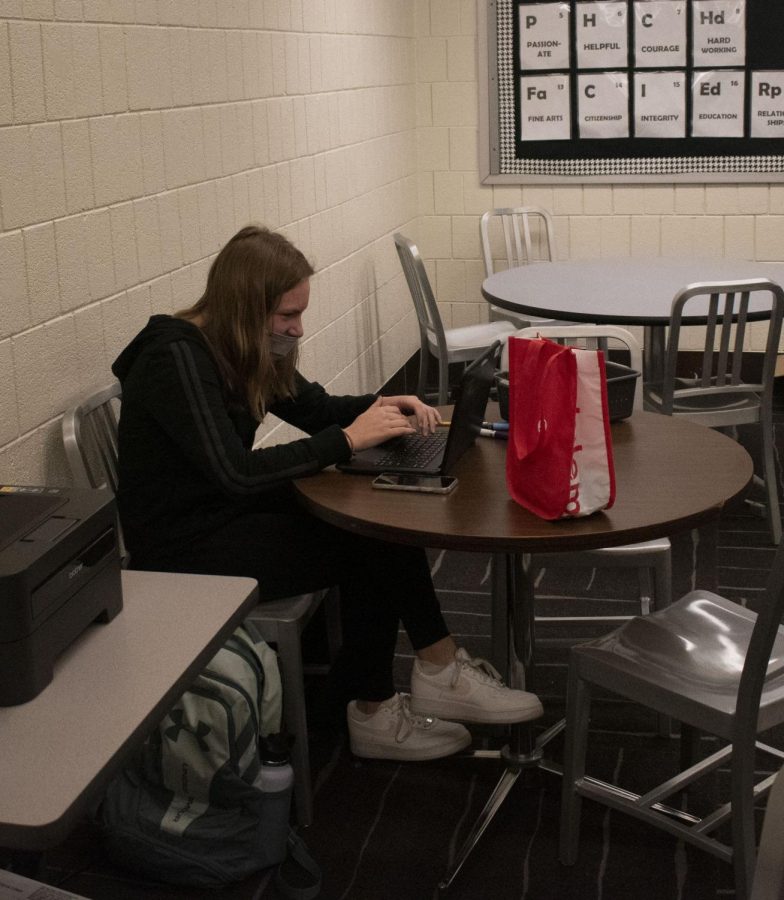A call for consistency on mask and dress code enforcement
Even in the absence of her peers, junior Lynnae Wollenweber sits in the U-Link and works on her homework all while following the mask policy.
November 16, 2021
The dress code and the mask policy: two topics floating through the hallways these days. There seem to be as many opinions as students and nearly as many different approaches to enforcing the rules.
“I would say that it’s the masks that are enforced more, not purposely, but they’re easier to see,” principal Andrea Markert said.
Not only is this policy easier to enforce because of its visibility, it is also a state mandate. Per Illinois’ executive order No. 87, “all individuals in Illinois … shall be required to cover their nose and mouth with a face covering when in an indoor public place.”
However, as pointed out by student body president Nick Leonard, the speed limit is also a state mandate and all drivers can see how that has been enforced.
“Speed limits are mandated by the state, but very few people follow those precisely as outlined by the law,” Leonard said.
Leonard is not alone in his desire to question the enforcement of the mask policy. Unfortunately for these students, however, the repercussions for not adhering to the masking policy may not be worth the risk, and certainly isn’t according to Markert.
“If you (the school) doesn’t enforce the mask policy you can be suspended from all sports,” Markert said, “and you could potentially lose funding.”
This punishment for the larger school community is, in part, one of the reasons why she feels so strongly about enforcing the policy.
As far as the dress code is concerned, students like junior Katie Bender have recently been advocating for more consistent enforcement. The inconsistencies Bender is concerned with are girls disproportionately getting dress coded, the methods used to dress code, and the reasons people are being dress coded.
“If someone’s getting dress-coded, give them a pass, have them go down to the office and just keep it consistent,” Bender said.
She, along with other students, have brought their concerns to the U-High administration and are currently working toward revising the dress code to make it more “fair and equal” for all students. Although this is welcomed by the administration, they have wondered why students are just now working toward reform when this has been a policy for years.
“I don’t know why people’s perception has suddenly changed that it’s been enforced more [this year],” Markert said, “because it honestly hasn’t.”
Students have made it clear in the past few months that they believe the enforcement increased at the beginning of the school year, and has since decreased in the past few weeks.
“I think the number [of enforced dress code violations] has definitely gone down, and I feel like that’s what matters,” Bender said.
This is, in part, due to the individual teacher’s perspectives on sending their students out of class to be dress coded or calling them out themselves.
“I think it’s a waste of time to send girls out of class if something is amiss with the dress code.” science teacher Donieka Solberg said, “but I have definitely asked students to wear aprons during the lab.”
As a chemistry teacher, she is concerned about exposed skin on lab days where the possibility of coming into contact with toxic chemicals is present. However, she is not alone in her hesitance to enforce the dress code.
“I’ve never had to [enforce the dress code],” David Harnish said, “and for me that comes down to the fact that the dress code is about if things are distracting to the learning environment.”
The commonality amongst student objections is around the perception that some punishments are taken to the extreme.
“One teacher approached me and a group of students who all had [our] masks down,” Leonard said, “and proceeded to single me out and cuss at me.”
Bender expressed a similar concern about the uneven approach to handling dress code violations.
“The embarrassment factor was part of the punishment of being dress coded,” Bender said, “and I felt like that was just unnecessary.”
Even as they are raising objections, students are approaching the matter methodically and respectfully.
“All students, whether they agree with it or not, have at least been respectful and polite,” Markert said.
In the end, these discussions reveal the need for reform in the consistency enforcing these policies. Markert, Leonard and Bender all agreed that such reform could happen eventually through the school’s vaccination rates or dress code reform.
“The enforcement of these types of rules is just so random, and I think that’s the main problem,” Bender said.

Anna • Nov 16, 2021 at 4:21 pm
Maybe the violations have gone down because it’s not 98° outside? But I agree they weren’t consistent with each student.